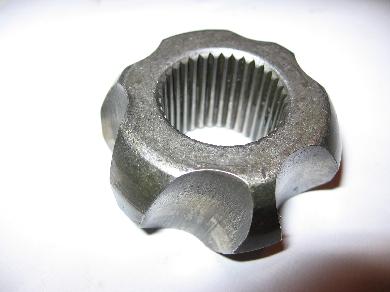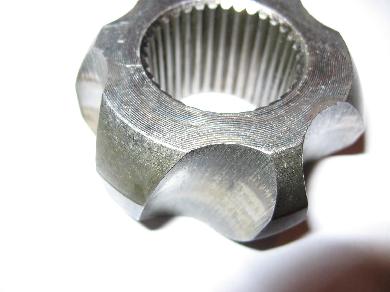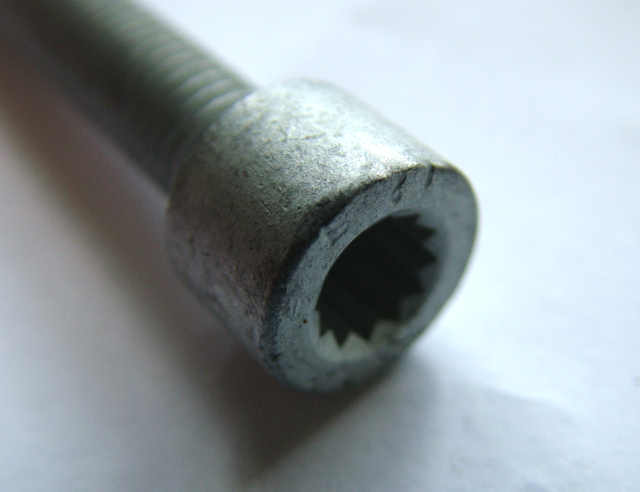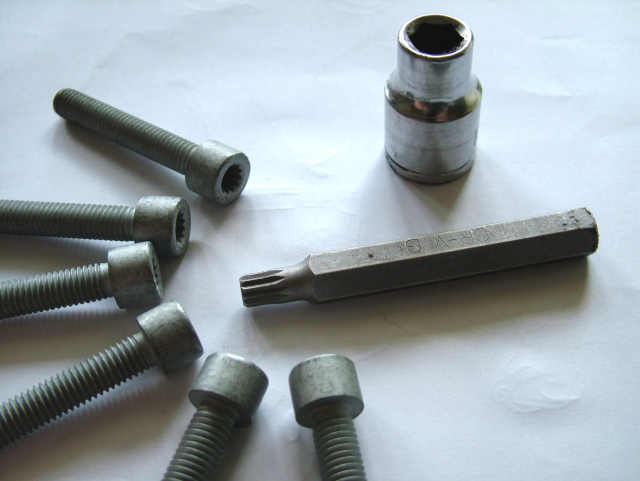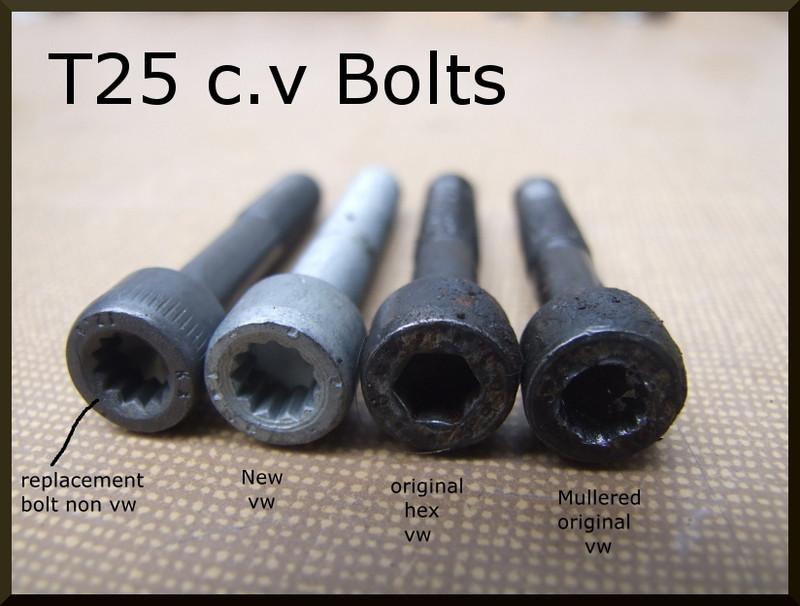Gearbox Clutch CVs CV joints repair
CV Joint Repair
Sarran's you tube video http://youtu.be/meTNBph3rUU
(see further down for CV bolts)
Hacksawbob the CV boot maybe held on with either 8mm 12 point internal spline, aka CV Joint tool aka triple square. OR 6mm hex/allen headed bolts, and maybe a mixture of the two! make sure you use the right tool for the job as these are a pig to remove if rounded common sense says replace them if they look iffy as next time they wont come off so easy and you will know the pain of using mole grips in confined spaces. The 8mm splined bit is available from GSF in 3/8 socket
A little cleaning and preparation can save you hours/days/weeks of frustration and scarred (and scared?) knuckles. Get a good torch wd40, air compressor, childs toothbrush etc to give the bolt heads a right good clean. You can get to all of them bar two with the wheel on ground then raise or roll forward to get to other two, A happy helper in the drivers seat putting it into neutral/Hbrake on and off whilst you loosen underneath the raised van can save you a bit of messing about. Or you can put the van in gear with the gear selector on the gearbox, undo the bolt, select neutral, rotate, repeat. Crack all the bolts off first then go around again removing them. Another top tip is to take it to a car wash and give the trailing arm a right good clean out before you start as when you come to fit the outers you will get grit and rust etc falling into your nice fresh CV grease. You will find that the CV is very heavy if you are trying to hold it in situ with one hand and fitting the bolts with the other, tie up the shaft or get a helper to hold it whilst you get the first bolt in. A hydraulic press is recommended to get the inner CV bearing off the shaft, although with wear it may slide off easily.
Fitting CV joint revisited
Just some notes after fitting one today and while its fresh. I had a split boot... but I though I would change the joint whilst I was there anyway. I have done this a few times and just some additional notes which may help people. Additional Tools required..
2 lb or 4 lb lump hammer.
27mm injector socket
Flat nosed circlip pliers (or adapted normal version read on)
MANY MANY GLOVES AND RAGS!!!
JIZER GUNK DE-GREASER
Tri square splined bit
I usually remove the wheel and jack the van, but but on this occasion I ran the van onto a 3'X1'X0.5' block of wood. I managed to get to all the bolts on the off side (diesel LHD if it matters?) without the wheel rotation whilst on axle stands. Super cleaned the area with Jizer/gunk and a stiff brush. The original 6mm VW hex sockets came off nice and clean and easy. grease was dripping every where though well ovedue for a change of grease even if the joint was still good and not noisy. I only had the standard circlip pliers which have a pair of round points. So I adapted them by grinding the outside faces flat It is not possible to remove the circlip with a round nosed set of circlip pliers, they must be flat nosed. I used the lump hammer to tap the old joint off once the circlip was out of the way it came off nice and easy, but I have had them needed to be pressed off in the past, (esp the outers). You can use a set of pullers to get the joint off too, this one came off with a bit of tapping with a 4lb lump hammer.
Fit the boot clamp, then the boot then the new CV joint. I tapped it on with a lump hammer till it was flush with the drive shaft, then I used a 27mm (injector) socket to tap it on further to reveal the circlip groove but any donut shaped of a suitable size would do you. Refit the bolts with serated washers and spreader plates recovered from the old fittment (they are not included in a boot kit from GKN/lobro/brickwerks. These spreader plate jobbies that go between the bolts, not sure what they do but they should be there! Then gease the joint up AFTER everything is in place I used the sachet and then about half as much again, be free whith it it is unlikely you will pack too much! But keep it SUPER CLEAN!!! dont get any grit in there!
Now when I came to tighten it all up I came accross a problem. My torque wrench was too big and chunky to get the tri square bit square onto the bolt head.... the head was being forced off centre by the CV boot. so I chewed up the bolt head ... very easily!!!! fortunately I had a genuine VAG bolt to go on.. But I was amazed at how easily the GKN 12 point was to chewed up...! I did mine up with a standard 3/8ths socket with the tri square socket removed from the 1/2 inch and it was all a lot easier. I will check them again after 50miles or so and make sure they aren't coming loose. a 3/8 torque wrench would be better.
CV Joint Assembly
HarryMann:
Now, I can't answer the question I'm raising without getting out all me greasy manuals and its late, but apart from aligning the large and small sticky out bits, there is supposed to be a right and a wrong way around - axially.
That is, the faces of the outer and inner races have chamfers on them, different depth chamfers each end and some makes have other markings.
Qu. Which way around do all these bits go, and does it matter?
Bentley (and other US articles) makes a big deal about this, and not only which way they go outer to inner, but then which side faces the shaft when installed... all highly friggin confusing I thought, especially as a new GKN one seemed not to agree, chamferwise, with aforesaid dictums. Having played Rubik's cube with it for quite long enough (pre-greasing up being the best time Idea ), settled for the way that it seemed to offer least resistance and jamming up at large angles. As for putting on the truck, think the circlip goes the least chamfered side of the inner race.
Will dig out the manuals unless someone knows the 'real way', 'right way' or indeed that it doesn't matter a jot for some makes, that it does for OEM joints, or vice versa... (I'm sure that's enough options Rolling Eyes )
90gms of the black stuff per joint? Just stuffing it inside the boot no good - roughly half from each side and really work into the cage. When they're just starting to clunk a bit, to give them another lease of life, or just 'cos you fancy it, squeeze the filthy boot around to work the grease back into the joint - silence - for a while. Clunking rear CVJs can upset smooth changing in lower gears, and put additional shock loads through the diff too.
A full service is: wash off and degrease, clean off all traces inspect, decide, significant track pitting/ galling a no-no, just wear but smooth tracks - OK if you're a tight-wad Reassemble - 'tis fun, honest - refit, regrease.
HarryMann: Yup, I was led to believe that articulation angle is compromised by assembling the wrong way around.
Grease: ETKA says repair kits include 90g (14" rear) and 120g (16" rear) joints I can get all 90g in, and again, led to believe that it's a good idea to put it all in. GSF do a big pot of 'medium' MOS2 cheap, but reckon they'd give you another sachet if asked nicely. If it was a repair kit, maybe 50g is meant not to service, but to top-up - or meant to have two sachets in - one for each side of joint. As with wheel bearings, perhaps never fill cavity 100% (overheat, melty grease) but that would be as mear as impossible with a booted joint. Release trapped air through boot sleeve before crimping up tight, but don't leave boot crushed,
SyncroSam: Clive, Is this the difference in chamfer you are referring to?
Top pic smoother edge, bottom pic sharper edge) - I thought sharp edge was driveshaft end as in goes on shaft first, but i probably wrong
simon Baxter
On the splines, the chamfer goes to the shaft end, the flat end is for the circlip. (ie gearbox side for the inner wheel side for the outer)
TD: Very interesting and great pictures, but I just throw them away when they knock and buy new ones, they are a cheap item compared to many things and outers last 70K +, inners much longer. They are the dirtiest, foulest things to take apart, even paraffin has a job to clean them. Still, makes a great hobby!
HarryMann: Can't say I disagree, just make sure they go in the metal skip, for recylcing or make-weights for your steel scrap!
Flibbertigibbet: but I would like to point out to the more ignorant amongst us what is sounds like is they need changing....ready -
Like a clucking chicken .....!!!!
CV Bolts
(Covkid)
Bolt Upgrade from hex to splined
After having a spate of CV bolts coming undone, and rather too familiar with pulling away from a junction only to lose all drive, I switched to splined bolts. Some vehicles may already have them fitted, in which case read no further but for those with allen key CV bolts, read on...
CV joints take a lot of abuse and since all the power from the engine is being transmitted through the driveshafts (more so if you're not light on your clutch), its important that everything is tight. CV boot kits do sometimes contain a set of bolts but they are often poor quality.
12 spline bolts (M8x48)provide for a more positive tightening sequence and also stop the bolts coming loose as you can get more torque on them. You also don't have the annoyance of trying to get an allen key at just the right angle to push it home. This can be particularly awkward on outside joints where there is limited room. 12 splines mean you're almost guaranteed to get the tool in first time. Perhaps more importantly, the allen key type often don't allow (particularly if worn) enough purchase or access to nip them up properly and they can eventually work their way out until the last couple of bolt snap during pull away and then you're stuck - often in the dark miles from anywhere or more likely, right in the middle of a busy junction in rush hour. This is by far the best way to put an end to these kind of issues.
All CV bolts must be high-tensile (stainless for instance would not be suitable). I managed to buy 24 top quality German ones on Ebay for around £14 (well over £30 from VW) and a splined bit (see below) for under £4 which fits any conventional 10mm hex socket. You must use the correct bit for these bolts - don't use a six-pointed star torx bit, it must be a 12 spline bit or you'll chew up the tool or the bolt. Tighten to 33ftlb 45Nm
CV bolts also need the right washers (friction type) [1] as well as the obligatory three plates/tabs for each joint but if your washers are missing and you're struggling to find the right ones, use spring washers or (at a pinch) rough up ordinary washers with a severe file. Thread lock is also a good idea if you can get all threads into which the bolts go, clean from the outset.
Removal
Like allen key bolts, if you have to remove them for any reason, clean any oil/grit/mud from the head recess carefully, to ensure the spline bit goes in fully, otherwise you run the risk of chewing them out during removal. A few seconds spent doing that can save hours of problems later. If you do encounter a completely stubborn bolt with a chewed head, I found the best way to get them started is to use a cold chisel and knock them round enough (anticlockwise) to break the bolt's grip and then get mole grips on them.
If you round a head on an outer bolt drill it out with a 7mm drill bit then hammer in a 7mm hex headed socket on an extension. This should give you enough purchase to remove it. If you really cant get it out, the final solution is to go through the wheel bearing removal procedure and pull the whole drive shaft out through the trailing arm still attached to the bearing and hub housing so you can work on it with better access. Steering_and_Suspension_Wheel_Bearings
